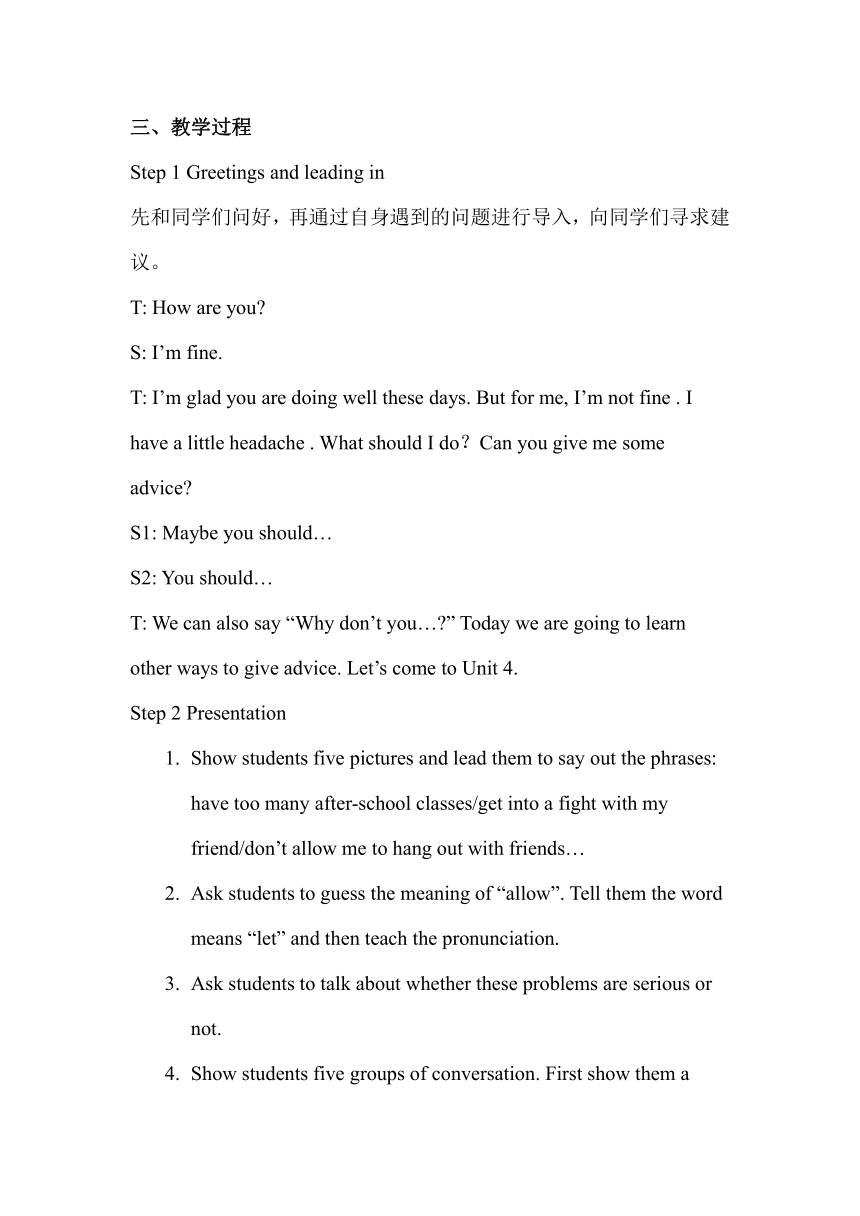人教版八年级下册 Unit 4 Why don't you talk to your parents? SectionA 1a-1c 教案
文档属性
| 名称 | 人教版八年级下册 Unit 4 Why don't you talk to your parents? SectionA 1a-1c 教案 |  | |
| 格式 | doc | ||
| 文件大小 | 33.5KB | ||
| 资源类型 | 教案 | ||
| 版本资源 | 人教新目标(Go for it)版 | ||
| 科目 | 英语 | ||
| 更新时间 | 2022-12-21 10:29:06 | ||
图片预览


文档简介
Unit 4 Why don't you talk to your parents
Section A (1a-1c)
一、教学目标:
1. 语言知识目标:
1) 能掌握以下单词:allow, wrong, midnight
能掌握以下句型:
1 —What’s wrong
—I’m really tried because I studied until midnight last night.
② You could/should…/Why don’t you… /Why not… /
What/How about… /You’d better…
2) 能了解以下语法:
(1)能够运用所学知识谈论问题和困难、提出建议并做出选择;
(2)能根据对方所提出的问题,给出一些合理的建议。
2. 情感态度价值观目标:
培养学生良好的合作意识,鼓励学生大胆表达自己的想法和意愿。正确认识生活中的一些困难,能采用正确的方式解决生活中的问题。
二、教学重难点
1. 教学重点:
1) Talk about the problems.
2) Learn the new language points.
2. 教学难点:能根据对方所提出的问题,给出一些合理的建议。学会表达建议的一些方式。
三、教学过程
Step 1 Greetings and leading in
先和同学们问好,再通过自身遇到的问题进行导入,向同学们寻求建议。
T: How are you
S: I’m fine.
T: I’m glad you are doing well these days. But for me, I’m not fine . I have a little headache . What should I do?Can you give me some advice
S1: Maybe you should…
S2: You should…
T: We can also say “Why don’t you… ” Today we are going to learn other ways to give advice. Let’s come to Unit 4.
Step 2 Presentation
1. Show students five pictures and lead them to say out the phrases: have too many after-school classes/get into a fight with my friend/don’t allow me to hang out with friends…
2. Ask students to guess the meaning of “allow”. Tell them the word means “let” and then teach the pronunciation.
3. Ask students to talk about whether these problems are serious or not.
4. Show students five groups of conversation. First show them a sample. Then lead them to fill in the missing part and then read.
Step 3 Listening
1. Play the recording for the students to listen and circle the problems you hear in 1a.
2. Play the recording again. Check the answers with the Ss.
3. Play the recording for twice again and ask them to fill in the blanks. Check the answers with the students.
4. Show the listening material and circle the important sentences of asking problems and giving advice.
5. Introduce them other useful sentences to help give advice by playing a micro video. Then add up “What/How about… /You’d better…” on the blackboard.
Step 4 Pairwork
Show students four famous stars, one student acts as a star, the other student acts as his or her friend. Ask them to role-play a conversation according to the sample I give.
Step 5 Emotional education
Show students a short video “Trouble is a friend”. Then tell them: “Trouble is our friend. She will find you no matter where you go. So why don’t you face the problems and
challenges bravely Be positive and learn to communicate.”
Step 6 Summary
Ask students to summarize the words, phrases, sentences of asking problems and giving advice.
Section A (1a-1c)
一、教学目标:
1. 语言知识目标:
1) 能掌握以下单词:allow, wrong, midnight
能掌握以下句型:
1 —What’s wrong
—I’m really tried because I studied until midnight last night.
② You could/should…/Why don’t you… /Why not… /
What/How about… /You’d better…
2) 能了解以下语法:
(1)能够运用所学知识谈论问题和困难、提出建议并做出选择;
(2)能根据对方所提出的问题,给出一些合理的建议。
2. 情感态度价值观目标:
培养学生良好的合作意识,鼓励学生大胆表达自己的想法和意愿。正确认识生活中的一些困难,能采用正确的方式解决生活中的问题。
二、教学重难点
1. 教学重点:
1) Talk about the problems.
2) Learn the new language points.
2. 教学难点:能根据对方所提出的问题,给出一些合理的建议。学会表达建议的一些方式。
三、教学过程
Step 1 Greetings and leading in
先和同学们问好,再通过自身遇到的问题进行导入,向同学们寻求建议。
T: How are you
S: I’m fine.
T: I’m glad you are doing well these days. But for me, I’m not fine . I have a little headache . What should I do?Can you give me some advice
S1: Maybe you should…
S2: You should…
T: We can also say “Why don’t you… ” Today we are going to learn other ways to give advice. Let’s come to Unit 4.
Step 2 Presentation
1. Show students five pictures and lead them to say out the phrases: have too many after-school classes/get into a fight with my friend/don’t allow me to hang out with friends…
2. Ask students to guess the meaning of “allow”. Tell them the word means “let” and then teach the pronunciation.
3. Ask students to talk about whether these problems are serious or not.
4. Show students five groups of conversation. First show them a sample. Then lead them to fill in the missing part and then read.
Step 3 Listening
1. Play the recording for the students to listen and circle the problems you hear in 1a.
2. Play the recording again. Check the answers with the Ss.
3. Play the recording for twice again and ask them to fill in the blanks. Check the answers with the students.
4. Show the listening material and circle the important sentences of asking problems and giving advice.
5. Introduce them other useful sentences to help give advice by playing a micro video. Then add up “What/How about… /You’d better…” on the blackboard.
Step 4 Pairwork
Show students four famous stars, one student acts as a star, the other student acts as his or her friend. Ask them to role-play a conversation according to the sample I give.
Step 5 Emotional education
Show students a short video “Trouble is a friend”. Then tell them: “Trouble is our friend. She will find you no matter where you go. So why don’t you face the problems and
challenges bravely Be positive and learn to communicate.”
Step 6 Summary
Ask students to summarize the words, phrases, sentences of asking problems and giving advice.
同课章节目录
- Unit 1 What's the matter?
- Section A
- Section B
- Unit 2 I'll help to clean up the city parks.
- Section A
- Section B
- Unit 3 Could you please clean your room?
- Section A
- Section B
- Unit 4 Why don't you talk to your parents?
- Section A
- Section B
- Unit 5 What were you doing when the rainstorm came
- Section A
- Section B
- Review of Units 1-5
- Unit 6 An old man tried to move the mountains.
- Section A
- Section B
- Unit 7 What's the highest mountain in the world?
- Section A
- Section B
- Unit 8 Have you read Treasure Island yet?
- Section A
- Section B
- Unit 9 Have you ever been to a museum?
- Section A
- Section B
- Unit 10 I've had this bike for three years.
- Section A
- Section B
